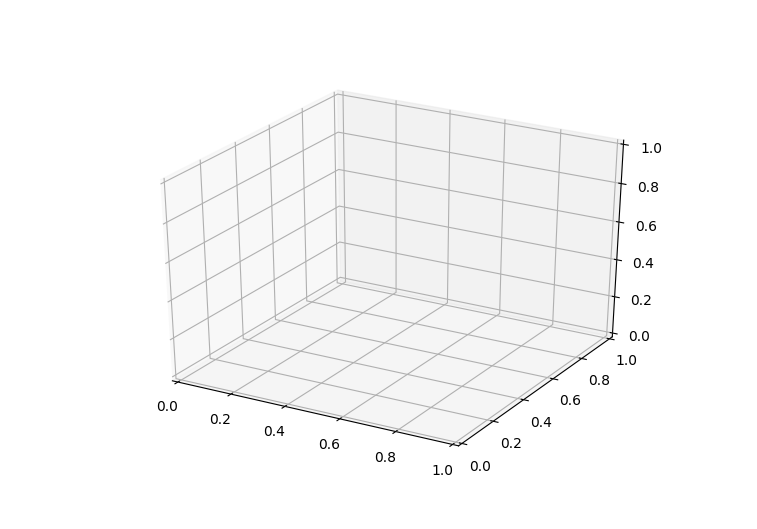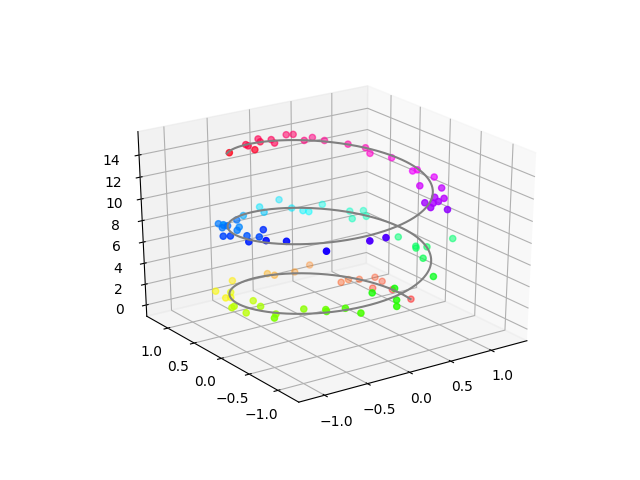how to use python to draw a 3d plot
An like shooting fish in a barrel introduction to 3D plotting with Matplotlib
![]()
Want to exist inspired? Come join my Super Quotes newsletter. 😎
Every Data Scientist should know how to create constructive data visualisations. Without visualisation, you lot'll exist stuck trying to crisis numbers and imagine thousands of information points in your head!
Across that, it's besides a crucial tool for communicating finer with not-technical business pale holders who'll more than easily empathize your results with a picture rather than just words.
Most of the data visualisation tutorials out there show the aforementioned bones things: scatter plots, line plots, box plots, bar charts, and estrus maps. These are all fantastic for gaining quick, high-level insight into a dataset.
Just wha t if we took things a pace further. A second plot can only show the relationships betwixt a single pair of axes x-y; a 3D plot on the other paw allows us to explore relationships of iii pairs of axes: 10-y, x-z, and y-z.
In this commodity, I'll give you an like shooting fish in a barrel introduction into the earth of 3D data visualisation using Matplotlib. At the cease of it all, y'all'll be able to add 3D plotting to your Data Science tool kit!
Just before we jump in, cheque out the AI Smart Newsletter to read the latest and greatest on AI, Machine Learning, and Information Science!
3D Besprinkle and Line Plots
3D plotting in Matplotlib starts by enabling the utility toolkit. Nosotros can enable this toolkit by importing the mplot3d library, which comes with your standard Matplotlib installation via pip. Just exist sure that your Matplotlib version is over 1.0.
Once this sub-module is imported, 3D plots can be created by passing the keyword projection="3d" to any of the regular axes creation functions in Matplotlib:
from mpl_toolkits import mplot3d import numpy as np
import matplotlib.pyplot every bit plt
fig = plt.figure()
ax = plt.axes(projection="3d")
plt.show()

At present that our axes are created we can beginning plotting in 3D. The 3D plotting functions are quite intuitive: instead of just besprinkle we call scatter3D , and instead of passing simply ten and y data, we pass over ten, y, and z. All of the other function settings such every bit colour and line type remain the same every bit with the 2nd plotting functions.
Here's an example of plotting a 3D line and 3D points.
fig = plt.figure()
ax = plt.axes(projection="3d")z_line = np.linspace(0, xv, 1000)
x_line = np.cos(z_line)
y_line = np.sin(z_line)
ax.plot3D(x_line, y_line, z_line, 'gray')
z_points = fifteen * np.random.random(100)
x_points = np.cos(z_points) + 0.1 * np.random.randn(100)
y_points = np.sin(z_points) + 0.1 * np.random.randn(100)
ax.scatter3D(x_points, y_points, z_points, c=z_points, cmap='hsv');
plt.evidence()

Here's the most awesome function about plotting in 3D: interactivity. The interactivity of plots becomes extremely useful for exploring your visualised data once you've plotted in 3D. Check out some of the unlike views I created past doing a simple click-and-elevate of the plot!
Surface Plots
Surface plots tin can be great for visualising the relationships among three variables across the unabridged 3D landscape. They give a full structure and view as to how the value of each variable changes across the axes of the ii others.
Constructing a surface plot in Matplotlib is a 3-pace procedure.
(1) Kickoff nosotros need to generate the actual points that will make upward the surface plot. Now, generating all the points of the 3D surface is impossible since there are an infinite number of them! So instead, nosotros'll generate just enough to be able to estimate the surface and then extrapolate the rest of the points. We'll define the x and y points and and then compute the z points using a office.
fig = plt.figure()
ax = plt.axes(projection="3d") def z_function(x, y):
return np.sin(np.sqrt(x ** two + y ** two))10 = np.linspace(-six, 6, 30)
y = np.linspace(-6, 6, 30)X, Y = np.meshgrid(x, y)
Z = z_function(10, Y)
(2) The 2nd step is to plot a wire-frame — this is our approximate of the surface.
fig = plt.figure()
ax = plt.axes(projection="3d") ax.plot_wireframe(Ten, Y, Z, color='green')
ax.set_xlabel('10')
ax.set_ylabel('y')
ax.set_zlabel('z')plt.show()
(3) Finally, nosotros'll project our surface onto our wire-frame judge and extrapolate all of the points.
ax = plt.axes(projection='3d')
ax.plot_surface(X, Y, Z, rstride=ane, cstride=one,
cmap='wintertime', edgecolor='none')
ax.set_title('surface'); Dazzler! In that location's our colourful 3D surface!
3D Bar Plots
Bar plots are used quite ofttimes in information visualisation projects since they're able to convey information, usually some blazon of comparison, in a elementary and intuitive way. The beauty of 3D bar plots is that they maintain the simplicity of 2D bar plots while extending their chapters to represent comparative data.
Each bar in a bar plot always needs ii things: a position and a size. With 3D bar plots, we're going to supply that information for all three variables ten, y, z.
We'll select the z axis to encode the peak of each bar; therefore, each bar will offset at z = 0 and take a size that is proportional to the value we are trying to visualise. The x and y positions volition represent the coordinates of the bar across the 2d plane of z = 0. We'll set up the x and y size of each bar to a value of i and then that all the bars take the same shape.
Check out the code and 3D plots below for an example!
fig = plt.figure()
ax = plt.axes(projection="3d")num_bars = 15
x_pos = random.sample(xrange(20), num_bars)
y_pos = random.sample(xrange(20), num_bars)
z_pos = [0] * num_bars
x_size = np.ones(num_bars)
y_size = np.ones(num_bars)
z_size = random.sample(xrange(twenty), num_bars)
ax.bar3d(x_pos, y_pos, z_pos, x_size, y_size, z_size, color='aqua')
plt.show()
Source: https://towardsdatascience.com/an-easy-introduction-to-3d-plotting-with-matplotlib-801561999725
0 Response to "how to use python to draw a 3d plot"
Post a Comment